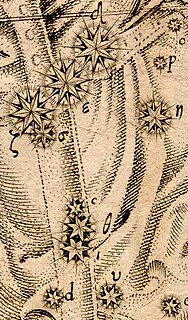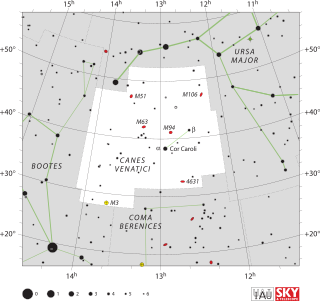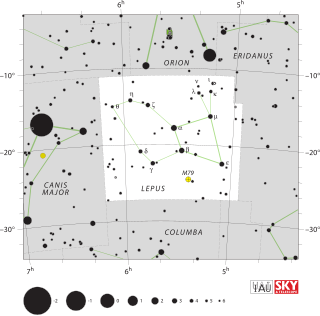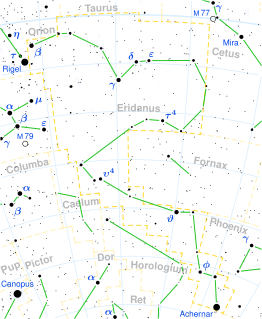Proper names of major planets
| | This section needs expansion. You can help by adding to it. (October 2012) |
Some astronomical objects have proper names (common names, popular names, traditional names), often in addition to catalogue numbers or other systematic designations. [1] [2] [ clarification needed ] This trivially includes the naked-eye planets as well as the Sun and Moon. A small number of stars have proper names in pre-modern astronomical tradition, but most naked-eye stars are identified by their Bayer or Flamsteed designations.
In modern astronomy, there has been a tradition of giving proper names to newly discovered heavenly bodies, initiated with the discovery of the planets beyond Saturn, and later extended to minor planets and moons.
The naming of astronomical objects and surface features in those objects is handled by two bodies of the International Astronomical Union (IAU). The names of major planets, satellites, and surface features in those bodies, are assigned by the Working Group on Planetary System Nomenclature. Names of comets and minor planets are handled by the Committee on Small Body Nomenclature. These bodies are also responsible for the dissemination of the names. The IAU's website has lists of all these names. [1]
In modern astronomy, the designation of stars is done by the International Astronomical Union (IAU). For the brightest stars, nomenclature is based on the Bayer designation, first published for a total of 1,564 naked-eye stars in 1603. Only a minority of these have proper names. [3] Many of the proper names that remain in use in modern astronomy are based on Arabic star names from medieval Islamic astronomy, which in turn was substantially based on Claudius Ptolemy’s Almagest , which contained the original Greek and Latin names for stars.
For example, the Arabs translated Opisthen (Οπισθεν "after" or "following") or Opiso (Οπισω "to follow after"), one of the original Greek names for the brightest star in Taurus, as Aldebaran (الدبران), which means "the Follower" in Arabic, because the star always follows behind the Pleiades as both move across the sky.
Most proper names for stars, especially the Arabic names, are descriptive of the locations of the stars within their parent constellations. For example, the star named Rigel (Arabic for "foot") marks the left foot of Orion the Hunter. Deneb (Arabic for "tail") marks the tail of Cygnus the Swan.
While most Arabic star names are translations from Ptolemy's Almagest , a small number of stars have retained names from native Arabian tradition; for example, there is a star in Lepus the Hare named Nihal, meaning "The Camels Quenching Their Thirst" in Arabic, because Lepus ("the hare") was seen as a caravan of camels in ancient Arabia.
A small number of Greek and Latin names have been preserved from antiquity, and have not been replaced by names derived from their Arabic equivalents. Examples include Sirius (Greek for "searing" or "scorching"), Arcturus (Greek for "Guardian of the Bear"), Capella (Latin for "Little She-goat"), and Spica (Latin for "Ear of Grain").
A small number of star names are also found in Chinese and Indian traditional astronomy, but as in Ptolemaic tradition, these traditions focussed on asterisms or groups of stars, and only a handful of stars were given individual names. Examples include Chinese Koo She ("bow and arrow") and Sanskrit Chitra "the bright one".
There are also contemporary proper names given to some stars, many of which refer to accomplished astronomers, deceased astronauts and English titles. For example, Gamma Velorum is named Regor, which is "Roger" spelled backwards; the name honors Astronaut Roger B. Chaffee, who died in the Apollo I tragedy. Other contemporary names include The Persian (Alpha Indi) and The Head of Hydrus (Alpha Hydri), Herschel's Garnet Star (Mu Cephei), Barnard's Star, etc.
Some independent astronomical and astrological businesses or organizations claim to sell the opportunity to "name a star". These names are not recognized by the International Astronomical Union (IAU). The IAU is the most influential organization that names stars and other celestial objects; it is the only one recognized by mainstream astronomers, on star maps, and in science textbooks.
| | This section needs expansion. You can help by adding to it. (October 2012) |
| | This section needs expansion. You can help by adding to it. (October 2012) |
| | This section needs expansion. You can help by adding to it. (October 2012) |
| | This section needs expansion. You can help by adding to it. (October 2012) |
| | This section needs expansion. You can help by adding to it. (October 2012) |

A Bayer designation is a stellar designation in which a specific star is identified by a Greek or Latin letter followed by the genitive form of its parent constellation's Latin name. The original list of Bayer designations contained 1,564 stars. The brighter stars were assigned their first systematic names by the German astronomer Johann Bayer in 1603, in his star atlas Uranometria. Bayer catalogued only a few stars too far south to be seen from Germany, but later astronomers supplemented Bayer's catalog with entries for southern constellations.

A constellation is an area on the celestial sphere in which a group of visible stars forms a perceived outline or pattern, typically representing an animal, mythological subject, or inanimate object.

Canes Venatici is one of the 88 constellations designated by the International Astronomical Union (IAU). It is a small northern constellation that was created by Johannes Hevelius in the 17th century. Its name is Latin for 'hunting dogs', and the constellation is often depicted in illustrations as representing the dogs of Boötes the Herdsman, a neighboring constellation.

Lepus is a constellation lying just south of the celestial equator. Its name is Latin for hare. It is located below—immediately south—of Orion, and is sometimes represented as a hare being chased by Orion or by Orion's hunting dogs.

Claudius Ptolemy was a mathematician, astronomer, astrologer, geographer, and music theorist, who wrote about a dozen scientific treatises, three of which were of importance to later Byzantine, Islamic, and Western European science. The first is the astronomical treatise now known as the Almagest, although it was originally entitled the Mathēmatikē Syntaxis or Mathematical Treatise, and later known as The Greatest Treatise. The second is the Geography, which is a thorough discussion on maps and the geographic knowledge of the Greco-Roman world. The third is the astrological treatise in which he attempted to adapt horoscopic astrology to the Aristotelian natural philosophy of his day. This is sometimes known as the Apotelesmatika but more commonly known as the Tetrábiblos, from the Koine Greek meaning "Four Books", or by its Latin equivalent Quadripartite.
In astronomy, stars have a variety of different stellar designations and names, including catalogue designations, current and historical proper names, and foreign language names.

The zodiac is a belt-shaped region of the sky that extends approximately 8° north or south of the ecliptic, the apparent path of the Sun across the celestial sphere over the course of the year. The paths of the Moon and visible planets are within the belt of the zodiac.

Cancer is one of the twelve constellations of the zodiac and is located in the Northern celestial hemisphere. Its old astronomical symbol is (♋︎). Its name is Latin for crab and it is commonly represented as one. Cancer is a medium-size constellation with an area of 506 square degrees and its stars are rather faint, its brightest star Beta Cancri having an apparent magnitude of 3.5. It contains two stars with known planets, including 55 Cancri, which has five: one super-earth and four gas giants, one of which is in the habitable zone and as such has expected temperatures similar to Earth. At the (angular) heart of this sector of our celestial sphere is Praesepe, one of the closest open clusters to Earth and a popular target for amateur astronomers.

The Almagest is a 2nd-century Greek-language mathematical and astronomical treatise on the apparent motions of the stars and planetary paths, written by Claudius Ptolemy. One of the most influential scientific texts in history, it canonized a geocentric model of the Universe that was accepted for more than 1200 years from its origin in Hellenistic Alexandria, in the medieval Byzantine and Islamic worlds, and in Western Europe through the Middle Ages and early Renaissance until Copernicus. It is also a key source of information about ancient Greek astronomy.

Andromeda is one of the 48 constellations listed by the 2nd-century Greco-Roman astronomer Ptolemy, and one of the 88 modern constellations. Located north of the celestial equator, it is named for Andromeda, daughter of Cassiopeia, in the Greek myth, who was chained to a rock to be eaten by the sea monster Cetus. Andromeda is most prominent during autumn evenings in the Northern Hemisphere, along with several other constellations named for characters in the Perseus myth. Because of its northern declination, Andromeda is visible only north of 40° south latitude; for observers farther south, it lies below the horizon. It is one of the largest constellations, with an area of 722 square degrees. This is over 1,400 times the size of the full moon, 55% of the size of the largest constellation, Hydra, and over 10 times the size of the smallest constellation, Crux.

Achernar is the primary component of the binary system designated Alpha Eridani, which is the brightest star in the constellation of Eridanus, and the ninth-brightest in the night sky. The two components are designated Alpha Eridani A and B. As determined by the Hipparcos astrometry satellite, it is approximately 139 light-years from the Sun.

Columba is a faint constellation designated in the late sixteenth century, remaining in official use, with its rigid limits set in the 20th century. Its name is Latin for dove. It takes up 1.31% of the southern celestial hemisphere and is just south of Canis Major and Lepus.
In ancient times, only the Sun and Moon, a few stars, and the most easily visible planets had names. Over the last few hundred years, the number of identified astronomical objects has risen from hundreds to over a billion, and more are discovered every year. Astronomers need to be able to assign systematic designations to unambiguously identify all of these objects, and at the same time give names to the most interesting objects, and where relevant, features of those objects.

In classical antiquity, the seven classical planets or seven luminaries are the seven moving astronomical objects in the sky visible to the naked eye: the Moon, Mercury, Venus, the Sun, Mars, Jupiter, and Saturn. The word planet comes from two related Greek words, πλάνης planēs and πλανήτης planētēs, both with the original meaning of "wanderer", expressing the fact that these objects move across the celestial sphere relative to the fixed stars. Greek astronomers such as Geminus and Ptolemy often divided the seven planets into the Sun, the Moon, and the five planets.

Eta Virginis is a triple star system in the zodiac constellation of Virgo. From parallax measurements taken during the Hipparcos mission it is about 265 light-years from the Sun. It has a combined apparent visual magnitude of 3.89, bright enough to be seen with the naked eye in dark skies.

51 Andromedae, abbreviated 51 And and formally named Nembus, is the 5th brightest star in the northern constellation of Andromeda, very slightly dimmer than the Andromeda Galaxy also being of 4th magnitude. It is an orange K-type giant star with an apparent magnitude of +3.59 and is about 169 light-years from the Earth/solar system. It is traditionally depicted as one of the two northern, far upper ends of the mythological, chained-to-the-rocks princess, the other being binary star system Gamma Andromedae.

Greek astronomy is astronomy written in the Greek language in classical antiquity. Greek astronomy is understood to include the Ancient Greek, Hellenistic, Greco-Roman, and Late Antiquity eras. It is not limited geographically to Greece or to ethnic Greeks, as the Greek language had become the language of scholarship throughout the Hellenistic world following the conquests of Alexander. This phase of Greek astronomy is also known as Hellenistic astronomy, while the pre-Hellenistic phase is known as Classical Greek astronomy. During the Hellenistic and Roman periods, much of the Greek and non-Greek astronomers working in the Greek tradition studied at the Museum and the Library of Alexandria in Ptolemaic Egypt.